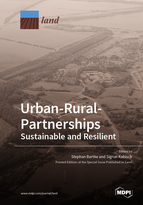Urban-Rural-Partnerships: Sustainable and Resilient
A special issue of Land (ISSN 2073-445X).
Deadline for manuscript submissions: closed (30 April 2022) | Viewed by 46865
Special Issue Editors
Interests: sustainable spatial development; institutional economics; land-use management; soil governance; sustainability economics
Interests: interdependencies between natural, social, and built environment; spatial consequences of demographic change; urban vulnerability and climate change; healthy living environments; international comparative case studies about land-use change and sociospatial differentiation
Special Issues, Collections and Topics in MDPI journals
Special Issue Information
Dear Colleagues,
We cordially invite the submission of original contributions dealing with interactions in regional systems, particularly between urban and rural actors, institutions and projects to tackle great societal challenges. These include topics such as equitable and healthy living conditions, climate change and extreme events, pandemic crises, digitalization, circular economy and material flows. Conceptual and methodological papers are welcomed as well as case studies which are dedicated to striking examples and providing transferable knowledge and solutions.
By focusing on urban–rural linkages and partnerships, our Special Issue aims at discussing new urban–rural imaginaries, integrating strategies and projects which explore present and future potentials in terms of sustainability and resilience. With these ambitions, we look to draw attention to the implementation of key topical targets including the UN Sustainable Development Goals, the UN Habitat Urban–Rural Linkages Guiding Principles, the New Leipzig Charter and the Territorial Agenda 2030.
The contributions shall stimulate learning processes on various levels, i.e., from the local level to entire regions to the broader European and international levels, in order to foster an understanding of integrated regional and urban–rural development. We encourage contributions which provide original knowledge as well as those aimed at closing the gap between available scientific knowledge on the one hand and decision-making in practice on the other. We offer a forum for exchange and unleashing synergies to reveal potentials for intensified urban–rural collaboration.
This Special Issue will include key results of the international conference “Sustainable & Resilient Urban-Rural Partnerships” from 25 to 27 November 2020, a hybrid event which will take place both in Leipzig, Germany, and online at www.urp2020.eu. Notwithstanding, additional submissions with strong references to the topic are welcomed.
Dr. Stephan Bartke
Prof. Dr. Sigrun Kabisch
Guest Editors
Manuscript Submission Information
Manuscripts should be submitted online at www.mdpi.com by registering and logging in to this website. Once you are registered, click here to go to the submission form. Manuscripts can be submitted until the deadline. All submissions that pass pre-check are peer-reviewed. Accepted papers will be published continuously in the journal (as soon as accepted) and will be listed together on the special issue website. Research articles, review articles as well as short communications are invited. For planned papers, a title and short abstract (about 100 words) can be sent to the Editorial Office for announcement on this website.
Submitted manuscripts should not have been published previously, nor be under consideration for publication elsewhere (except conference proceedings papers). All manuscripts are thoroughly refereed through a single-blind peer-review process. A guide for authors and other relevant information for submission of manuscripts is available on the Instructions for Authors page. Land is an international peer-reviewed open access monthly journal published by MDPI.
Please visit the Instructions for Authors page before submitting a manuscript. The Article Processing Charge (APC) for publication in this open access journal is 2600 CHF (Swiss Francs). Submitted papers should be well formatted and use good English. Authors may use MDPI's English editing service prior to publication or during author revisions.
Keywords
- New urban–rural imaginaries to support equity in living conditions
- Robust regional systems coping with climate change and extreme events
- Regional governance approaches
- Integrated land-use management
- Urban–rural metabolism and circular economy







